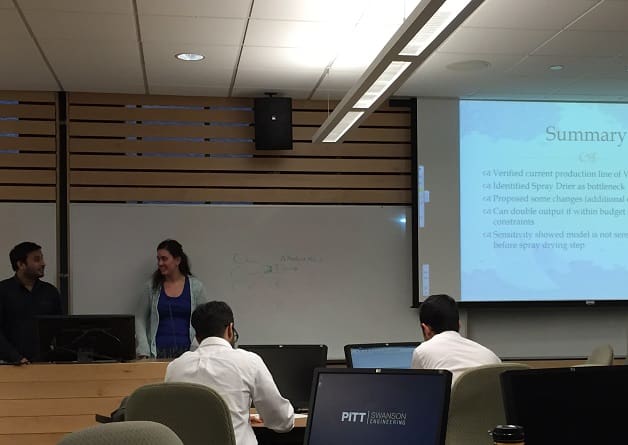
Simulation Report for Vayhan Coffee Limited Production
INDUSTRY
Manufacturing
AUTHOR(S)
R. Medikonda & K. Foster
ORGANIZATION
University of Pittsburgh
Video
Introduction
This project aims to model the production line of Vayhan Coffee Limited (VCL). VCL is a leading coffee manufacturing company in India, which exports coffee to different countries across the globe. They produce different blends or tastes within the two types of soluble coffee, namely Spray Dried & Granulated, in order to suit any specific market requirement. The manufacturing facility currently can produce 3600 MT of instant coffee per year in both spray dried and agglomerated varieties and is run by a team of high experienced and trained quality professionals to deliver the products to suit customer needs and profile. The manufacturing plant that has been considered for this project is located in Andhra Pradesh, India.
For this model, the VCL manufacturing process for five final products, denoted herein as products A, B, C, D, and E, is simulated. Three of the products (A, B, and C) are spray-dried, while the other two products (D and E) are granulated coffees. The first step in the simulation process represents retrieval of four different grades of coffee beans from inventory, and the last step of the simulation represents production of the final instant coffee product. The simulation is used to identify bottlenecks in the process and provide recommendations for ways to maximize output.
Project Objectives
- Determine the efficiency of the current production line.
- Identify and reduce any bottlenecks in the process
- Make changes to the facility layout to improve the productivity
Summary and Conclusions

We have effectively modeled the current production line at the VCL facility. The results we obtained are consistent with their production of 3600 MT per year. We were able to identify that the spray drier is causing a bottle neck, and thus we proposed an additional spray drier be added to the facility if within the budget and space constraints of VCL. Additionally, we have proposed adding additional storage and intermediate tanks to increase VCL’s ability to quickly change from one product mix to another. The simulated results of these changes indicate that VCL can double their current production by adding the specified equipment. Additionally, out sensitivity analysis showed that the pull production model is not sensitive to change in the order in which inventory is processed. The model is also not sensitive to change in the process before the spray drier. Namely, double roasting capacities had no effect on the output. Furthermore, while we suggest adding separate storage tanks for each product mix, the process is not sensitive to the sizes of these tanks which may have advantages from a managerial perspective.
More Student Projects
Expansion Project for an Airport Security Area
January 18, 2024
Resiliency of the Pittsburgh International Airport
January 18, 2024
Increasing Customer Satisfaction At Antalya Airport
January 18, 2024